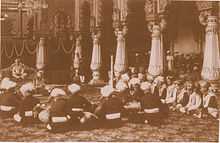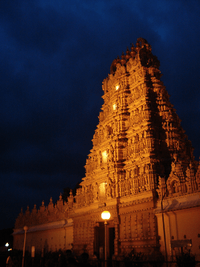Mysore Palace
| Mysore Palace | |
|---|---|
.jpg) Mysore Palace | |
| Built | 1912 |
| Architect | Henry Irwin |
| Architectural style(s) | Indo-Saracenic |



The Palace of Mysore (also known as the Amba Vilas Palace) is a palace situated in the city of Mysore in southern India. It is the official residence of the Wodeyars - the erstwhile royal family of Mysore, which ruled the princely state of Mysore for over seven centuries. The palace also houses two durbar halls (ceremonial meeting hall of the royal court).
Mysore is commonly described as the City of Palaces, however, the term "Mysore Palace" refers specifically to the one within the old fort.
Mysore palace is now one of the most famous tourist attractions in India after Taj Mahal with more than 2.7 million visitors.[1] Although tourists are allowed to visit the palace, they are not allowed to take photographs inside the palace. Price of admission for foreign tourists is 200 INR, and 40 INR for Indians. All visitors must remove their footwear to enter the palace.
History
The Wodeyar kings first built a palace in Mysore in the 14th century; it was demolished and constructed multiple times. The regent of Mysore, Her Royal Majesty Maharani Vani Vilas Sannidhna, and her son the Maharaja of Mysore His Highness Rajarshi Sri Sir. Krishnaraja Wodeyar IV commissioned the British architect-Lord Henry Irwin-to build a new palace in the place of the old one after it turned into ashes owing to a fire accident.[2] In the meanwhile, the royal family stayed in the very close by Jaganmohan Palace. Construction of the current palace was commissioned in 1897, completed in 1912, and expanded later around 1940 under His Highness Maharaja Sri Sir. Jayachamarajendra Wadiyar, the last Maharaja of Mysore Kingdom. The construction was completed in year 1912. But slowly the beautification of the fort was also taken up and the inhabitants of the fort were slowly shifted out to newer extension built outside. The present Public Durbar Hall wing was also added much later around 1940.
Architecture
The architectural style of the palace is commonly described as Indo-Saracenic, and blends together Hindu, Muslim, Rajput, and Gothic styles of architecture. It is a three-stone structure, with marble domes and a 145 ft five-storied tower. The palace is surrounded by a large garden.
The three-storied stone building of fine gray granite with deep pink marble domes was designed by Henry Irwin. The facade has several expansive arches and two smaller ones flanking the central arch, which is supported by tall pillars.
Above the central arch is an impressive sculpture of Gajalakshmi, the goddess of wealth, prosperity, good luck, and abundance with her elephants.
Special events
.jpg)

Every autumn, the Palace is the venue for the famous Mysore Dasara festival, during which leading artists perform on a stage set up in the palace grounds. On the tenth day of the festival Vijaya Dashami, a parade with caparisoned elephants and other floats originate from the palace grounds.
Dasara is the most extravagant festival of Mysore. The Dasara festival is celebrated in the months of September and October of each year.
The festival celebrates and commemorates the victory of the great Goddess Durga, after she slew the demon, Mahishasura, and thereby, symbolizing the triumph of good over evil according to Hindu mythology. Some call her Chamundeshwari.
This festival has been celebrated by the Wodeyars at Srirangapatna from 1610 and in Mysore with great pomp from 1799 and the tradition still is carried on although the scale of the celebrations has diminished. The Dasara festivities have become an integral part of the culture and life in Mysore.
To celebrate this festival the Palace of Mysore is illuminated with more than 96,000 lights during that two-month period.
Unique rooms
- Ambavilasa
This was used by the king for private audience, and is one of the most spectacular rooms. Entry to this opulent hall is through an elegantly carved rosewood doorway inlaid with ivory that opens into a shrine to Ganesha. The central nave of the hall has ornately gilded columns, stained glass ceilings, decorative steel grills, and chandeliers with fine floral motifs, mirrored in the pietra dura mosaic floor embellished with semi-precious stones.
- Gombe Thotti (Doll’s Pavilion)
Entry to the palace is through the Gombe Thotti or the Doll’s Pavilion, a gallery of traditional dolls from the nineteenth and early twentieth centuries. The pavilion also houses a fine collection of Indian and European sculpture and ceremonial objects like a wooden elephant howdah (frame to carry passengers) decorated with 84 kilograms of gold.
- Kalyana Mantapa
The Kalyana Mantapa or marriage hall is a grand octagonal-shaped pavilion with a multi-hued stained glass ceiling with peacock motifs arranged in geometrical patterns. The entire structure was wrought in Glasgow, Scotland. The floor of the Mantapa continues the peacock theme with a peacock mosaic, designed with tiles from England. Oil paintings, illustrating the royal procession and Dasara celebrations of bygone years, make the walls more splendid.
Temples

The palace complex includes twelve Hindu temples. The oldest of these was built in the 14th century, while the most recent was built in 1953.
Some of the more famous temples are:
- Someshvara Temple, dedicated to God Lord Shiva
- Lakshmiramana Temple, dedicated to God Lord Vishnu
- Shwetha Varahaswamy Temple, dedicated to Lord Varahaswamy, one of the 10 incarnations of lord Vishnu
and many more.
Attractions
The Palace houses several rooms of importance. These include:
- Audience Chamber: This was the Hall of Private Audience, where the king would confer with his ministers. It was also the chamber in which he gave audience to people deserving special attention.
- Public Durbar: The Diwan-e-aam was a public hall where the general population could meet the king at scheduled times with petitions.
- Royal wedding hall
- Armoury: The palace houses an armoury, which contains a collection of different types of arms used by the members of the royal family. These include weapons that were used in the 14th century (lances, cutlasses, etc.), as well as weapons that were used in the early twentieth century (pistols, etc.).
See also
- Palaces of Mysore
- Laxmi Niwas Palace in Bikaner, Rajasthan
- New Palace, Kolhapur of the Bhonsle Chhatrapatis
- Jai Vilas Mahal, Gwalior of the Scindias
- Rajwada, Indore of the Holkars
- Shaniwar Wada, Pune of the Peshwas
- Thanjavur Maratha palace of the Bhonsles
References
External links
| Wikimedia Commons has media related to Mysore Palace. |
- Official Virtual Tour website of Mysore Palace
- Mysore Palace
- Official Mysore Dasara Website
- Palaces of Mysore
- Mysore Palace lighting
| ||||||||||||||||||||||||||
| ||||||||||||||||||||||||||
Coordinates: 12°18′14″N 76°39′16″E / 12.30389°N 76.65444°E